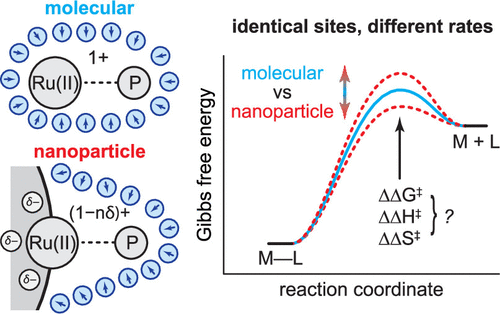当前位置:
X-MOL 学术
›
Chem. Mater.
›
论文详情
Our official English website, www.x-mol.net, welcomes your
feedback! (Note: you will need to create a separate account there.)
Dissociative Ligand Exchange at Identical Molecular and Carbon Nanoparticle Binding Sites
Chemistry of Materials ( IF 7.2 ) Pub Date : 2020-09-01 , DOI: 10.1021/acs.chemmater.0c02838 Corey J. Kaminsky 1 , Sterling B. Chu 1 , Richard I. Sayler 2 , Seokjoon Oh 1 , Patrick W. Smith 1 , Joshua Wright 3, 4 , R. David Britt 2 , Yogesh Surendranath 1
Chemistry of Materials ( IF 7.2 ) Pub Date : 2020-09-01 , DOI: 10.1021/acs.chemmater.0c02838 Corey J. Kaminsky 1 , Sterling B. Chu 1 , Richard I. Sayler 2 , Seokjoon Oh 1 , Patrick W. Smith 1 , Joshua Wright 3, 4 , R. David Britt 2 , Yogesh Surendranath 1
Affiliation

|
Ligand exchange reactions at nanoparticle surfaces are critical to the formation and function of nanomaterials. The kinetics of surface ligand exchange derive from a combination of factors related to local binding site structure and the surface reaction environment. Here, we isolate the contributions of the surface reaction environment by comparing the ligand exchange kinetics of a carbon nanoparticle binding site to that of a molecular analogue with identical binding site structure. Specifically, we synthesize a graphite-conjugated pseudo-octahedral ruthenium complex, GCC-Ru, bearing a single exchangeable phosphine ligand and compare its kinetics of ligand exchange to that of the identical molecular Ru complex. Using a combination of spectroscopies, we establish common molecular coordination environments and oxidation states for GCC-Ru and the molecular analogue and use 19F NMR to interrogate the kinetics and mechanism of ligand exchange. We find that surface conjugation results in a 2- to 3-fold rate enhancement, which derives from compensating changes to ΔH‡ and ΔS‡ for a common dissociative mechanistic pathway. Based on these data, we develop a model that explains these changes to the activation parameters through charge screening by the carbon and its impact on the local solvent environment at the surface binding site. This work highlights the key role of the solvent environment at a conductive surface in facilitating ligand exchange reactions.
中文翻译:

在相同的分子和碳纳米粒子结合位点的解离配体交换。
纳米颗粒表面的配体交换反应对于纳米材料的形成和功能至关重要。表面配体交换的动力学源自与局部结合位点结构和表面反应环境有关的因素的组合。在这里,我们通过比较碳纳米粒子结合位点与具有相同结合位点结构的分子类似物的配体交换动力学来分离表面反应环境的贡献。具体而言,我们合成了带有单个可交换膦配体的石墨共轭伪八面体钌络合物GCC-Ru,并将其配体交换动力学与相同的分子Ru络合物进行了比较。结合使用光谱学,19 F NMR询问配体交换的动力学和机理。我们发现,表面共轭导致速率提高了2到3倍,这是由于补偿了常见的分离机制途径的ΔH ‡和ΔS ‡的变化而引起的。基于这些数据,我们开发了一个模型,该模型通过碳的电荷筛选及其对表面结合位点局部溶剂环境的影响,解释了活化参数的这些变化。这项工作突显了导电表面上溶剂环境在促进配体交换反应中的关键作用。
更新日期:2020-10-13
中文翻译:

在相同的分子和碳纳米粒子结合位点的解离配体交换。
纳米颗粒表面的配体交换反应对于纳米材料的形成和功能至关重要。表面配体交换的动力学源自与局部结合位点结构和表面反应环境有关的因素的组合。在这里,我们通过比较碳纳米粒子结合位点与具有相同结合位点结构的分子类似物的配体交换动力学来分离表面反应环境的贡献。具体而言,我们合成了带有单个可交换膦配体的石墨共轭伪八面体钌络合物GCC-Ru,并将其配体交换动力学与相同的分子Ru络合物进行了比较。结合使用光谱学,19 F NMR询问配体交换的动力学和机理。我们发现,表面共轭导致速率提高了2到3倍,这是由于补偿了常见的分离机制途径的ΔH ‡和ΔS ‡的变化而引起的。基于这些数据,我们开发了一个模型,该模型通过碳的电荷筛选及其对表面结合位点局部溶剂环境的影响,解释了活化参数的这些变化。这项工作突显了导电表面上溶剂环境在促进配体交换反应中的关键作用。











































 京公网安备 11010802027423号
京公网安备 11010802027423号